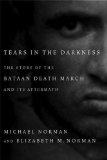“The evil that men do lives after them,” William Shakespeare wrote in Julius Caesar. The magnitude of the human cruelty and violence is often reflected when the events have a name virtually everyone recognizes. One of those is the Bataan Death March, the name given to the Japanese forcing more than 70,000 American and Filipino prisoners of war to walk up to 60 miles from the Bataan peninsula in the Philippines to a central transfer point in April 1942, the midst of the hottest season, with little or no food or water and subject to being beaten, shot or bayoneted at the whim of their captors. More than 65 years later, that event is explored masterfully in Tears in the Darkness: The Story of the Bataan Death March and Its Aftermath.
 The book, written by husband and wife Michael and Elizabeth M. Norman, combines broad perspective and history with specific, personal events from a wide range of observers and participants. The book is made even more powerful by the range of personal perspective it uses. Although the story of Ben Steele of Montana helps provide a framework, the Normans give us viewpoints of a significant number of Americans and Filipinos, as well as Japanese.
The book, written by husband and wife Michael and Elizabeth M. Norman, combines broad perspective and history with specific, personal events from a wide range of observers and participants. The book is made even more powerful by the range of personal perspective it uses. Although the story of Ben Steele of Montana helps provide a framework, the Normans give us viewpoints of a significant number of Americans and Filipinos, as well as Japanese.
Steele, whose drawings illustrate the book, works well as an archetype of the American experience. He joined the Army Air Corps before the war and ended up being stationed in the Philippines. He was among the many U.S. military men on the island who were forced into combat roles for which they hadn’t really been trained. He was on the Death March and in the largest prison camp set up after it. He was placed on a road building crew in the middle of the jungle under conditions worse than the prison camp. He spent time in what passed for the central hospital for American prisoners, one the equipment available for a tracheotomy were a piece of rubber tube and a safety pin. He was then was crammed with more than 1,000 others into the hold of tanker and shipped to Japan as forced labor in a coal mine.
Thus, Steele saw virtually the entire spectrum of the Bataan experience. As noted, though, his story is just part of Tears in the Darkness. The Normans do an excellent job relating the events and circumstances leading up to the battle of the Philippines, the battle in the Bataan peninsula and the death march. Likewise, they follow Norman and others home after the war and report on the war crimes trial of Masaharu Homma, the Japanese general who commanded the force that invaded the Philippines.
Both for those aspects of the book and the core story — the march, its aftermath and the treatment of the prisoners — the Normans interviewed more than 400 people in the U.S., Japan and the Philippines for the book. They make use of private diaries and letters, including those of Japanese military men, to not only explore what happened but to provide first hand insight into how it impacted those involved. Many of these excerpts can only be called harrowing. Yet they not only reveal what the Japanese did, but the impact of continued brutality on the human psyche and the levels to it might lead a man to resort.
Yet Tears in the Darkness doesn’t read like some stodgy historical tome. It is cogent and engrossing but never dogmatic. Granted, we are all appalled at what takes place in the course of the book. With the contemporary firsthand accounts and even explaining, for example, just what lack of water does to a person, the Normans allow us to attempt to grasp just how excruciating and horrendous things were. “Every man was forced to look inward,” they write. “Those who saw nothing — and there were many — abandoned all hope of ever seeing home again. It was almost as if death itself had become contagious[.]”
There is, of course, no good reason for the maltreatment, starvation, torture and massacre of the prisoners. Still, the book goes beyond the emotional aspect of the story to look at how and why this may have happened. This examination is broad also. For example, the Normans look not only at cultural issues and the raw emotion of revenge, but also how American and Filipino preparedness played a role as this appalling chapter of American, Filipino and Japanese history opened.
It isn’t often someone recommends a book that explores such evil, horrifying and torturous events. Tears in the Darkness, though, is essential reading for anyone who wants a full picture of the Bataan Death March or a touch of insight into why evil lives longer than the men responsible for it.
They lived on hope because hope was all they had.
Michael and Elizabeth Norman, Tears in the Darkness







